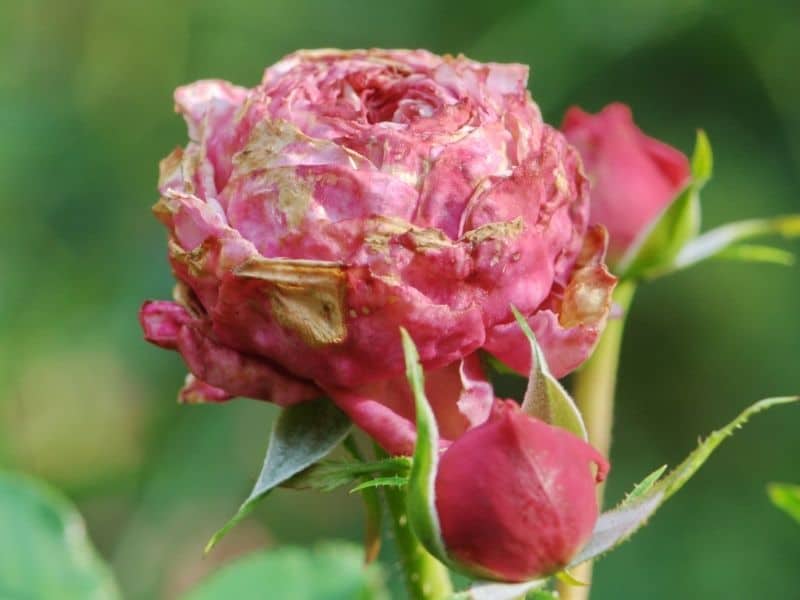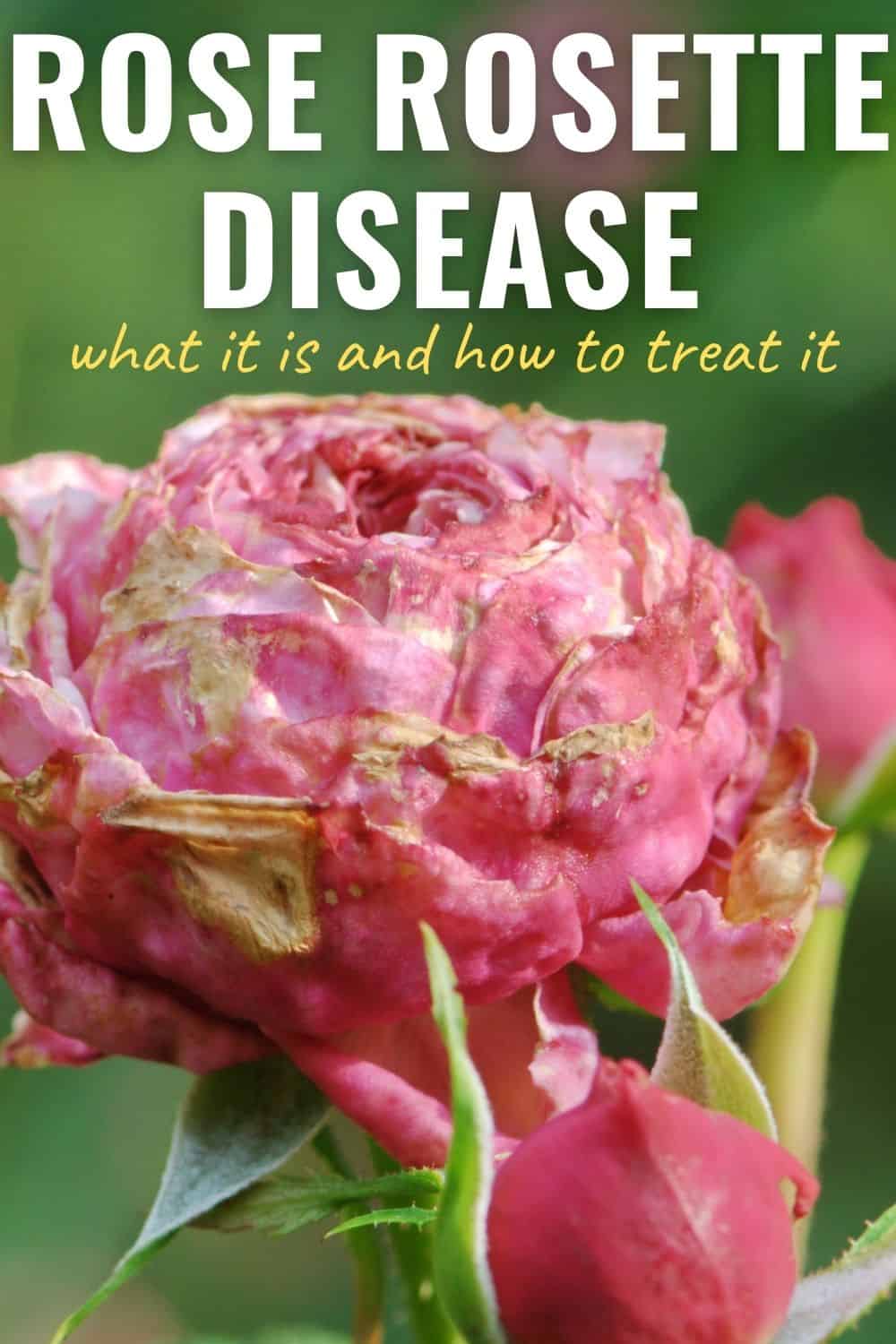Favored among writers and gardeners alike, roses are classic flowers that fit in almost any landscape. But what happens when a disease threatens your flourishing rose collection? One such threat is rose rosette disease, and in the sections below, we will explore what it is, how to treat it, and how to prevent it from infecting your roses in the first place.

What Is Rose Rosette Disease?
A devastating disease specific to the genus Rosa, rose rosette disease causes abnormal growth of plant tissue, making what should be beautiful rose plants unsightly. It is caused by the aptly named rose rosette virus, which spreads via the microscopic eriophyid mite. Its main plant host is the multiflora rose (Rosa multiflora), a noxious weed originally imported to the United States, ironically, for its disease resistance.
Symptoms and diagnosis of rose rosette disease
Rose rosette disease symptoms vary depending on the cultivar. Often, plants develop elongated stems with reddish leaves that don’t become green. Infected plants might also produce elongated shoots that swell and grow excess thorns.
The name of the disease comes from a common symptom often referred to as “rosettes” or “witches’ brooms,” in which a cluster of shoots and branches grow from a single node. Rose rosette disease can also cause defoliation, dieback, and increased susceptibility to cold damage and other diseases. The ten most common symptoms include the following:
- elongated and thickened stems
- red leaves that do not turn green with maturity
- excessive prickles/thorns
- distorted leaves
- witches’ brooms/rosettes
- distorted or discolored flowers
- branch dieback
- yellowed and/or stunted plants
- increased susceptibility to other diseases
- reduced winter hardiness
Many of these symptoms can also signify herbicide drift injury or even nutrient deficiency, so it’s important to properly diagnose the disease before attempting to treat it.
First, check the distribution map on roserosette.org to see whether rose rosette disease has been identified in your area. If it has not (and perhaps even if it has), consider whether the symptoms could be caused by herbicide drift or nutrient deficiency.
After ruling out other causes, you can take a six- to 12-inch sample of the affected rose plant to your local extension office for examination.
The life cycle of the rose rosette virus
As previously mentioned, the rose rosette virus is transmitted by the tiny, wingless eriophyid mite, which travels on the wind as well as contaminated equipment and clothing.
Transmission typically occurs during the plants’ active growth period, from May through mid-July. At the end of this period, symptoms will begin to develop on newly infected plants. Although the virus is inactive in the winter, symptoms can also appear on new growth the following spring.
How to treat rose rosette disease
Unfortunately, there is no cure for rose rosette disease, though you can take measures to control it. When symptoms first appear, completely remove any symptomatic shoots, placing them directly in a bag as you cut them and then discarding them in the garbage to prevent further spread.
Watch the infected plant(s) closely, as symptomatic shoots often continue to appear. If this happens, place a plastic bag over the entire plant, cut it off at the base, and then dig out the roots, being as thorough as possible. Discard the entire plant, including roots, in the garbage, then clean all tools used and put your clothes with the dirty laundry.
Then, in late winter, heavily prune back all remaining roses by about two-thirds, discarding all pruned foliage in the garbage and cleaning tools and clothing as before.
Spray an organic horticultural oil or insecticidal soap to kill any remaining mites, treating monthly through the growing season except in periods of high temperatures (check the product label for specifics).
Preventing rose rosette disease
Because the eriophyid mite tends to hide near buds and leaf scars, regular deadheading and proper pruning can help prevent rose rosette disease. Avoid using leaf blowers near roses, as they create wind for the tiny mites to ride on.
When planting new rose bushes, space them properly so the foliage of one plant does not touch that of another. Interplanting roses with other types of plants can also help prevent the spread of the virus in case a plant becomes infected.
And of course, keep all plants healthy, especially during drought, by providing appropriate levels of moisture and nutrients and controlling any diseases or pests.
Finally, scout for and completely remove any multiflora roses in the vicinity. Not only will you be protecting your roses from rose rosette disease, but you will also be helping control an invasive species that threaten native ecosystems.
Rose rosette virus FAQs
Can rose rosette disease spread to other plants?
Rose rosette disease only infects members of the Rosa genus (roses), so it will not affect other species. However, the tiny mites that transmit it can move from one rose to another, spreading the virus through a garden, especially if the roses are planted close together. It can also spread from pruned foliage to live plants, so always be sure to clean up thoroughly after pruning, and if you suspect an infection, discard the clippings in the garbage.
What can I plant after rose rosette?
After fully removing and properly disposing of entire infected plants, you can plant new roses in the same location. However, you may want to wait a month or two to let the mites die off first before planting more roses; non-rose plants can be planted immediately.
Make sure to space new roses properly so that the branches don’t touch, making it difficult for mites to travel from one plant to another. For even greater protection, interplant other types of plants between roses.
Can Drift roses get rose rosette disease?
Yes, most rose varieties can get rose rosette disease, including Drift roses.
How does the rose rosette disease spread?
A microscopic mite called the eriophyid mite transmits the rose rosette virus by feeding on infected plants and then feeding on healthy plants. The mites travel on the wind, clothing, and equipment, and they can move between roses that are planted close together.
Where is rose rosette disease a problem?
Rose rosette disease has been recorded in nearly 40 states, though it is more widespread in some than others. A distribution map on roserosette.org shows in which counties the virus has been reported (see our link a bit higher on this page).
Can I replant the area with roses?
Yes, though you need to make sure all parts, including roots, of all diseased plants, have been removed first. See “What can I plant after rose rosette?” above.
Are there any roses that don’t get the rose rosette virus?
Few, if any, rose varieties are immune to the rose rosette virus. However, the Top Gun rose is one of the most resistant, and many species of roses, such as European burnet rose (R. spinosissima) and Virginia shrub rose (R. virginiana), are highly resistant as well.
Ensuring healthy roses
While it can be disappointing to have to dig out an established rose bush, doing so can keep other plants healthy, and proper measures can help prevent transmission. Even if your garden roses have been fortunate enough to not have experienced rose rosette disease, taking steps now will reduce the likelihood of infection, so you can continue to stop and smell the roses every summer.




11 Best Companion Plants For Roses
Sunday 1st of August 2021
[…] They require constant protection from blackspot, Botrytis blight, stem cankers, mosaic virus, and rose rosette, not to mention attacks from aphids, beetles, stem cutter bees, spider mites, midge, and […]